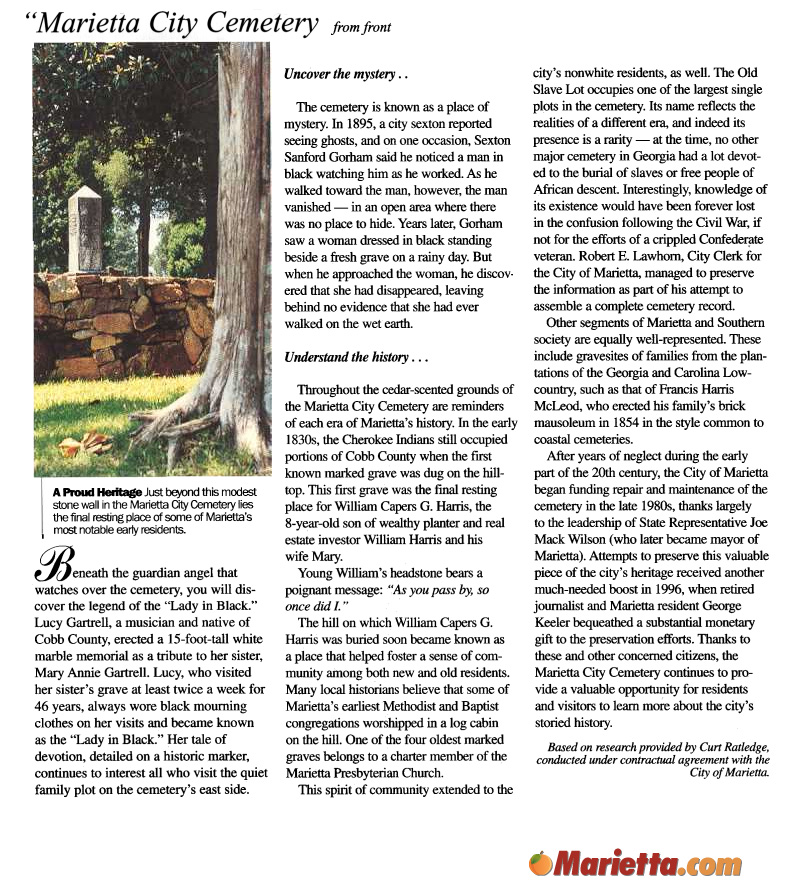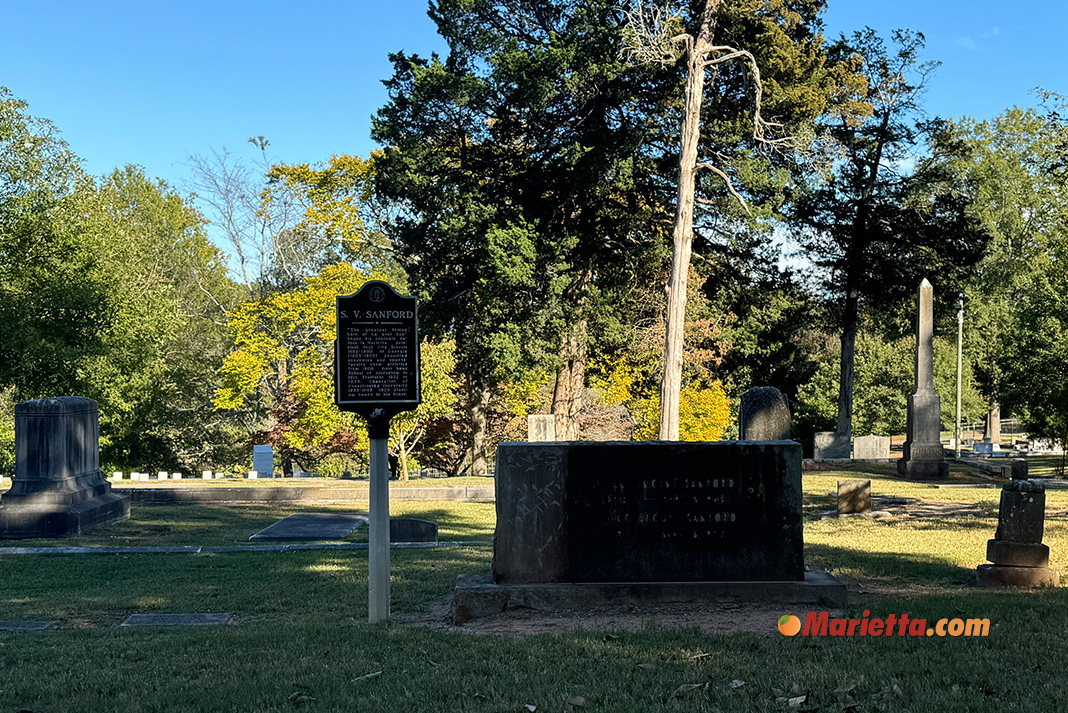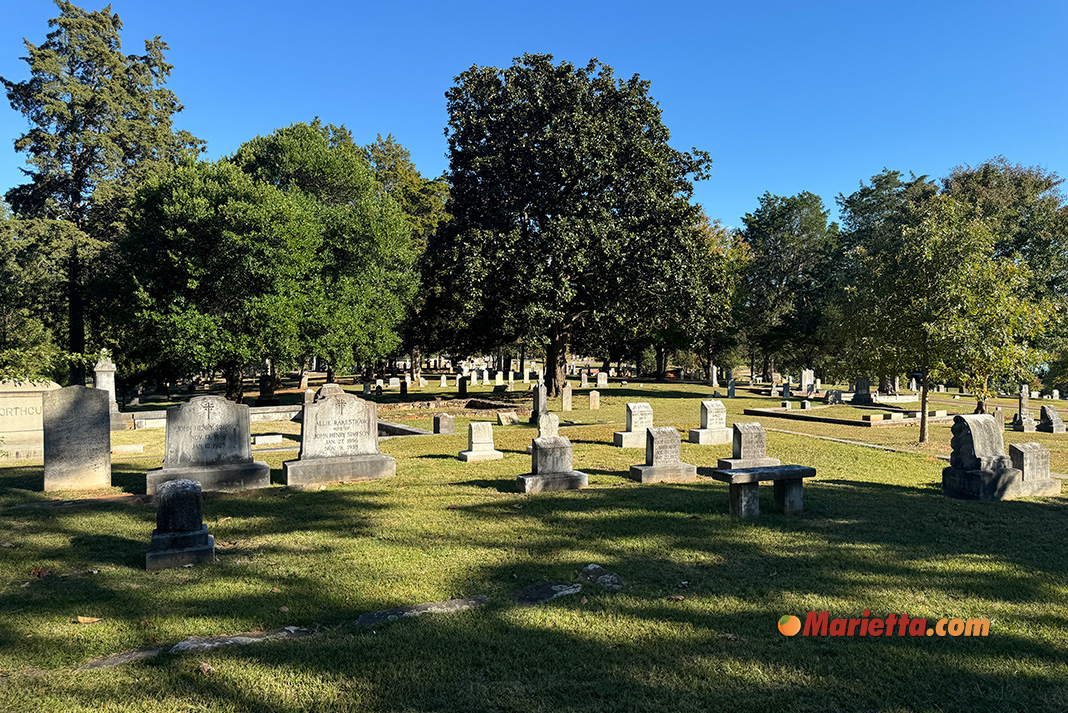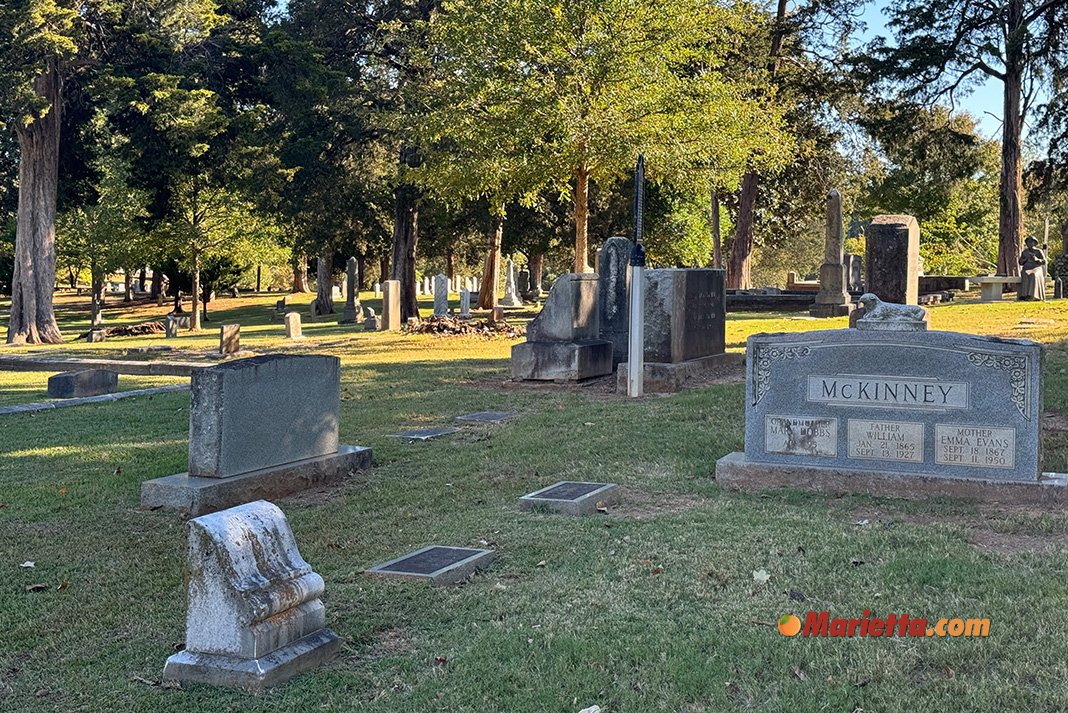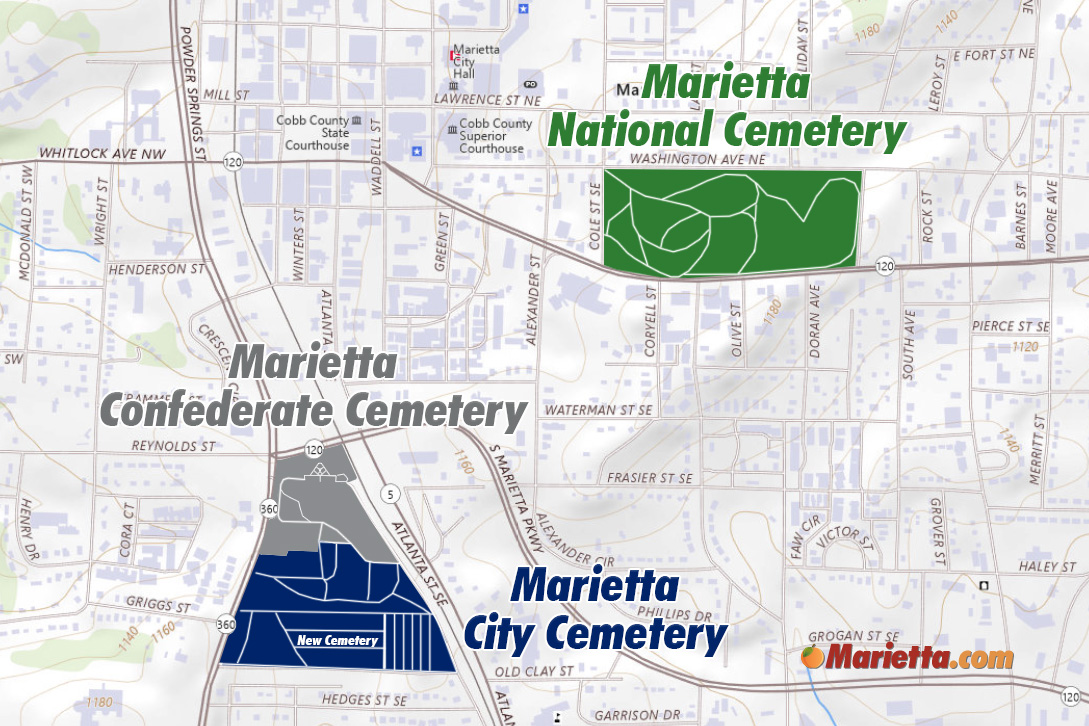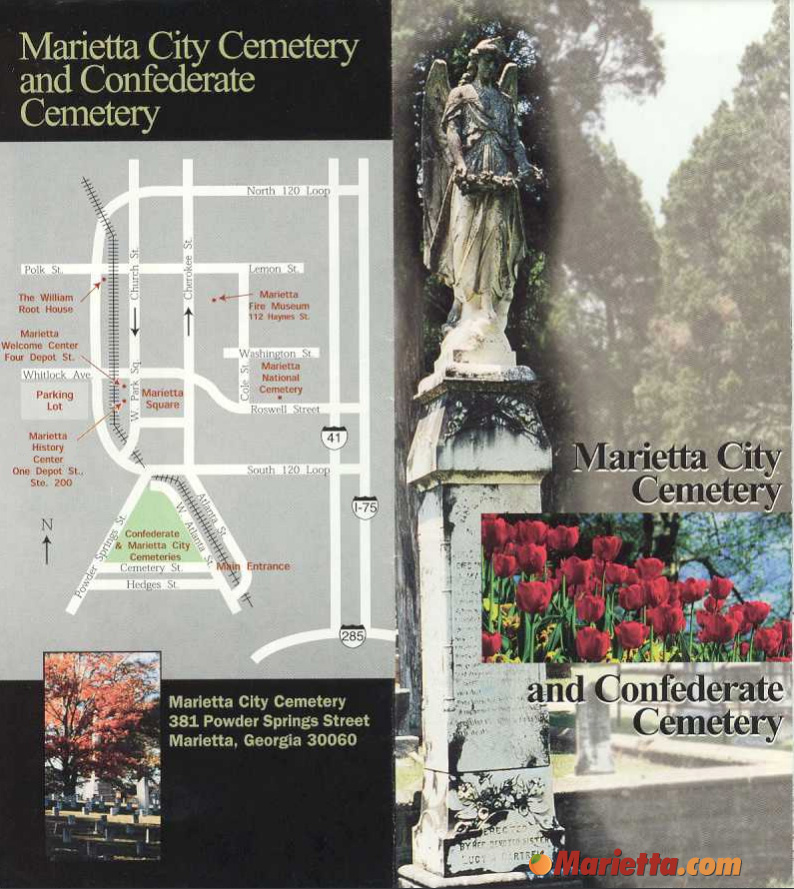 The Marietta City Cemetery has been a part of Georgia’s history since its establishment in 1831, at a time when native Americans were still living in Cobb County. Unlike many other burial grounds of the era, the cemetery is notable for its approach that welcomed individuals of various races, religions, and backgrounds without segregation. This lack of separation was quite unconventional for Georgia in the 1800s, and it adds to the unique character of this cemetery.
The Marietta City Cemetery has been a part of Georgia’s history since its establishment in 1831, at a time when native Americans were still living in Cobb County. Unlike many other burial grounds of the era, the cemetery is notable for its approach that welcomed individuals of various races, religions, and backgrounds without segregation. This lack of separation was quite unconventional for Georgia in the 1800s, and it adds to the unique character of this cemetery.
Marietta City Cemetery tells the stories of early residents, the builders and shapers of the town. It’s home to the graves of several former mayors of Marietta and even a former mayor of Smyrna. One notable individual buried here is Steadman Vincent Sanford, a former president of the University of Georgia, whose name lives on in the school’s football stadium. Another is U.S. Senator Alexander Stephens Clay, the only Cobb County native ever elected to the U.S. Senate. Clay’s achievements are inscribed on a 20-foot-high granite obelisk, complete with a powerful message that captures his resilience: “He retreated with the aspects of a victor, and though he succumbed, he seemed to conquer.”
A Tragic Tale: Mary Phagan
Among the cemetery’s more infamous stories is that of Mary Phagan, a young girl whose murder shook the entire state. In 1913, 13-year-old Mary was tragically killed on Confederate Memorial Day. The case attracted widespread attention, eventually leading to the lynching of the accused—a controversial event that still leaves questions unanswered to this day. The sorrow felt by Mary’s community at her untimely death is immortalized in a simple but heart-wrenching epitaph: “Sleep, little girl; sleep in your humble grave but… know that many an aching heart in Georgia beats for you.”
Unsung Heroes: Reverend Thomas Milton Allen
The cemetery isn’t only a place for politicians and tragic figures; it’s also the final resting place for individuals whose efforts left a lasting impact. Reverend Thomas Milton Allen is one such individual. Born into servitude in 1833, Allen rose from his beginnings to become a key figure in Marietta’s African-American community. He was a charter member of Zion Baptist Church, founded in 1866, and served as its second pastor. Reverend Allen also went on to organize multiple other congregations and helped establish the first association for African-American churches in 1890.
Guardian Angel: The Lady in Black
One of the cemetery’s more intriguing legends involves the “Lady in Black.” Lucy Gartrell, a local musician, visited her sister’s grave at least twice a week for 46 years, always dressed in black mourning attire. Her devotion led to her becoming known as the “Lady in Black,” and her story is commemorated with a marker in the cemetery. Her tale continues to fascinate visitors to this day, offering a glimpse into enduring familial love.
Mysteries of the Past
For those interested in the supernatural, Marietta City Cemetery offers its own share of eerie tales. City sexton Sanford Gorham reported seeing unexplainable figures as early as 1895, including a man in black who disappeared without a trace and a woman in black who vanished beside a fresh grave. These stories add a touch of mystery to the cemetery, making it a favorite spot for ghost enthusiasts and history buffs alike.
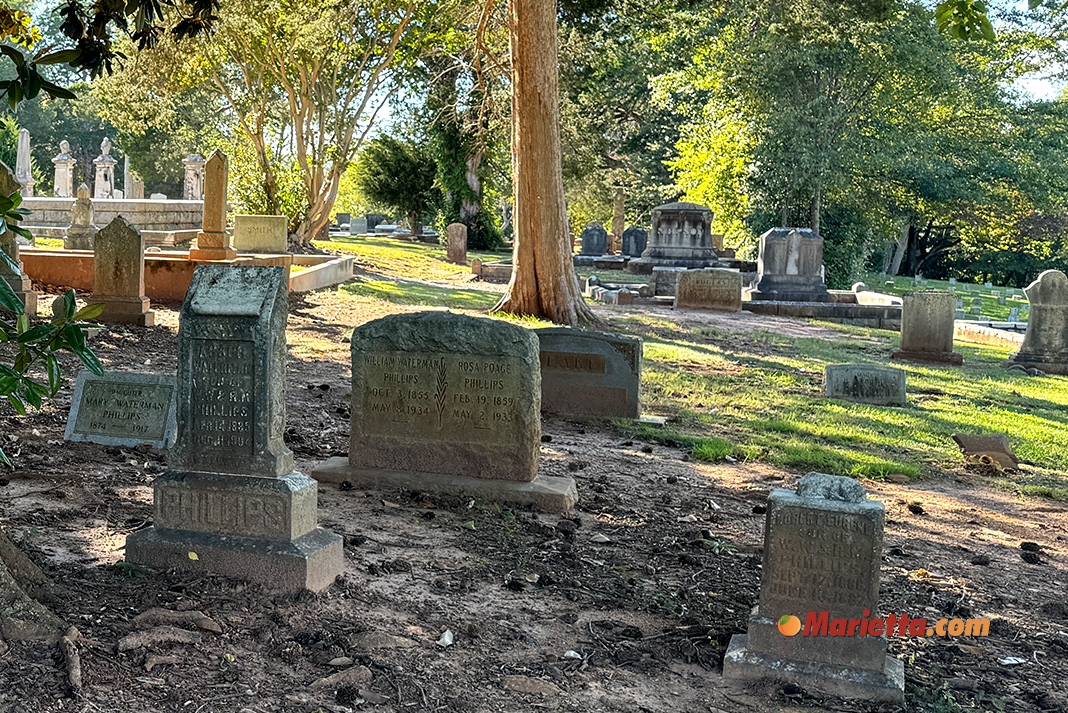 Historical Roots
Historical Roots
The earliest known burial in the cemetery dates back to the 1830s, when 8-year-old William Capers G. Harris was laid to rest on the hilltop—a place that would soon become a prominent part of Marietta’s landscape. His poignant epitaph reads: “As you pass by, so once did I,” serving as a reminder of life’s fleeting nature. The hill became a significant part of the city’s history, serving as both a cemetery and a cultural landmark.
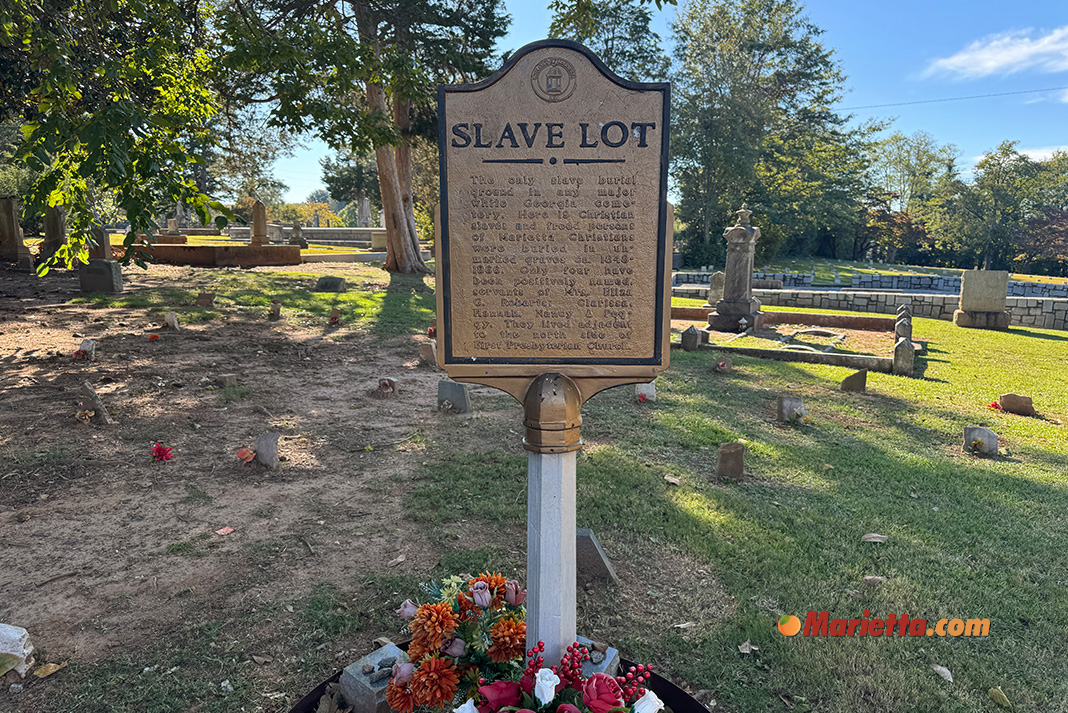
The Old Slave Lot is another unique aspect of Marietta City Cemetery. Its presence is unusual for its time—it includes a lot specifically designated for the burial of enslaved and free African-Americans, something not seen in any other major cemeteries in Georgia during that period. The efforts of Robert E. Lawhorn, a Confederate veteran who became the city clerk, ensured that these records were preserved, saving this history from being lost forever.
Restoration and Preservation
The cemetery experienced a period of neglect in the early 20th century but saw renewed restoration efforts starting in the 1980s, supported by local leadership and financial contributions from individuals such as George Keeler. These initiatives have helped maintain the cemetery as a well-preserved piece of Marietta’s heritage.
Marietta City Cemetery offers a window into the history of the city and the varied lives of its residents. From early community leaders to unsung heroes and eerie legends, every corner of this cemetery has a story to tell.
Location:
Hours:
Open daily from dusk to dawn
Admission:
Free
Phone:
(770) 794-5601
Address:
420 West Atlanta St SE
Marietta, GA 30064
You might also be interested in:
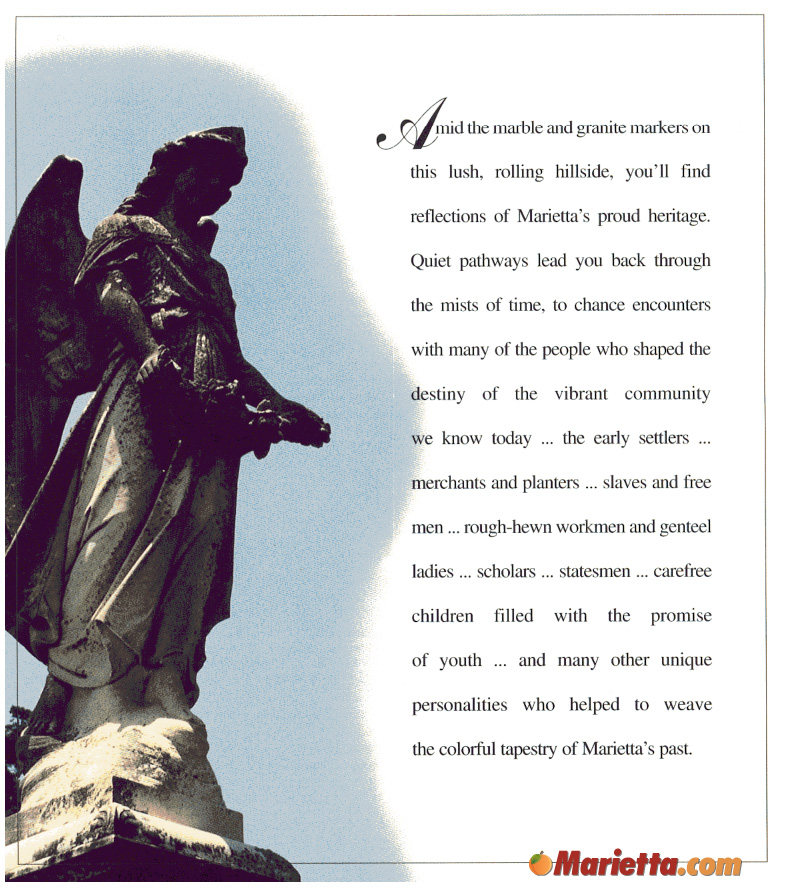
Amid the marble and granite markers on this lush, rolling hillside, you’ll find reflections of Marietta’s proud heritage. Quiet pathways lead you back through the mists of time, to chance encounters with many of the people who shaped the destiny of the vibrant community we know today … the early settlers merchants and planters … slaves and free men … rough-hewn workmen and genteel ladies … scholars … statesmen … carefree children filled with the promise of youth and many other unique personalities who helped to weave the colorful tapestry of Marietta’s past.
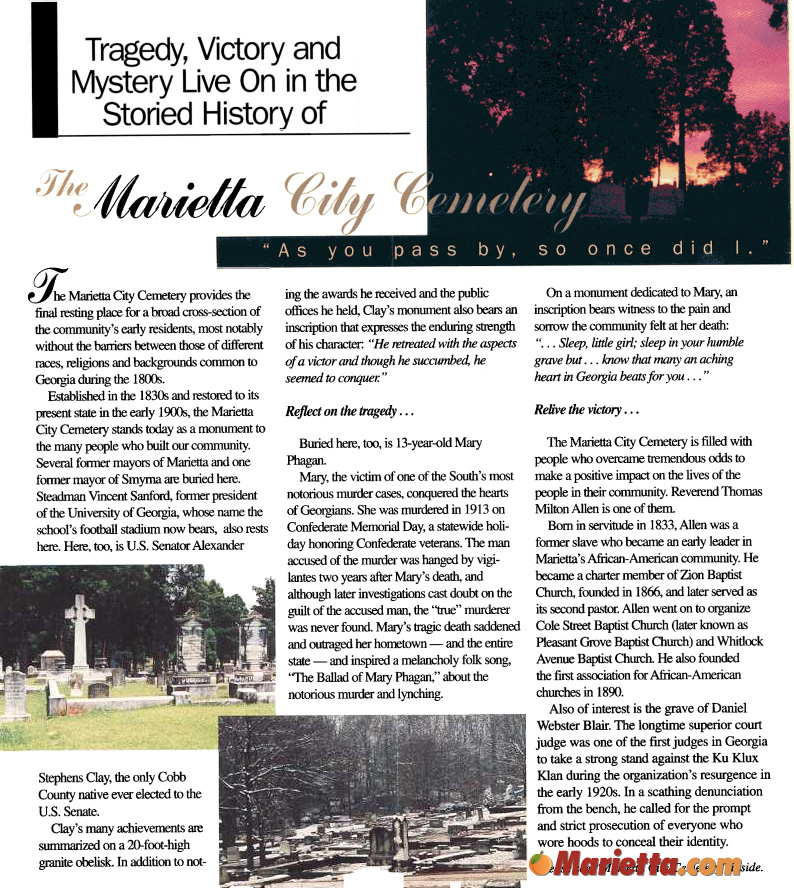
Tragedy, Victory, and the Mystery Live On in the Storied History of The Marietta City Cemetery
“As you pass by, so once did I.”
Marietta City Cemetery provides the final resting place for a broad cross-section of the community’s early residents, most notably without the barriers between those of different races, religions, and backgrounds common to Georgia during the 1800s.
Established in the 1830s and restored to its present state in the early 1900s, the Marietta City Cemetery stands today as a monument to the many people who built the community. Several former mayors of Marietta and one former mayor of Smyrna are buried here.
Steadman Vincent Sanford, former president of the University of Georgia, whose name the school’s football stadium now bears, also rests here. Here, too, is U.S. Senator Alexander Stephens Clay, the only Cobb County native ever elected to the U.S. Senate.
Clay’s many achievements are summarized on a 2O-foot-high granite obelisk. In addition to noting the awards he received and the public offices he held, Gay’s monument also bears an inscription that expresses the enduring strength of his character: “He retreated with the aspects of a victor and though he succumbed; he seemed to conquer.”
Reflect on the tragedy…
Buried here, too, is 13-year-old Mary Phagan. Mary, the victim of one of the South’s most notorious murder cases, conquered the hearts of Georgians. She was murdered in 1913 on Confederate Memorial Day, a statewide holiday honoring Confederate veterans. The man accused of the murder was hanged by vigilantes two years after Mary’s death, and although later investigations cast doubt on the guilt of the accused man, the “true” murderer was never found. Mary’s tragic death saddened and outraged her hometown—and the entire state—and inspired a melancholy folk song, “The Ballad of Mary Phagan,” about the notorious murder and lynching.
On a monument dedicated to Mary, an inscription bears witness to the pain and sorrow the community felt at her death:
“. . . Sleep, little girl; sleep in your humble grave but. . . know that many an aching
heart in Georgia beats for you. . .”
Relive the victory…
The Marietta City Cemetery is filled with people who overcame tremendous odds to make a positive impact on the lives of the people in their community. Reverend Thomas Milton Allen is one of them.
Born in servitude in 1833, Allen was a former slave who became an early leader in Marietta’s African-American community. He became a charter member of Zion Baptist Church, founded in 1866, and later served as its second pastor. Allen went on to organize Cole Street Baptist Church (later known as Pleasant Grove Baptist Church) and Whitlock Avenue Baptist Church. He also founded the first association for African-American churches in 1890.
Also of interest is the grave of Daniel Webster Blair. The longtime superior court judge was one of the first judges in Georgia to take a strong stand against the Ku Klux Klan during the organization’s resurgence in the early 1920s. In a scathing denunciation from the bench, he called for the prompt and strict prosecution of everyone who wore hoods to conceal their identity.
Beneath the guardian angel that watches over the cemetery, you will discover the legend of the “Lady in Black.” Lucy Gartrell, a musician and native of Cobb County, erected a 15-foot-tall white marble memorial as a tribute to her sister, Mary Annie Gartrell. Lucy, who visited her sister’s grave at least twice a week for 46 years, always wore black mourning clothes on her visits and became known as the “Lady in Black.” Her tale of devotion, detailed on a historic marker, continues to interest all who visit the quiet family plot on the cemetery’s east side.
Uncover the mystery…
The cemetery is known as a place of mystery. In 1895, a city sexton reported seeing ghosts, and on one occasion, Sexton Sanford Gorham said he noticed a man in black watching him as he worked. As he walked toward the man, however, the man vanished—in an open area where there was no place to hide. Years later, Gorham saw a woman dressed in black standing beside a fresh grave on a rainy day. But when he approached the woman, he discovered that she had disappeared, leaving behind no evidence that she had ever walked on the wet earth.
Understand the history…
Throughout the cedar-scented grounds of the Marietta City Cemetery are reminders of each era of Marietta’s history. In the early 1830s, the Cherokee Indians still occupied
portions of Cobb County when the first known marked grave was dug on the hilltop. This flfSt grave was the final resting place for William Capers G. Harris, the 8-year-old son of wealthy planter and real estate investor William Harris and his wife Mary.
Young William’s headstone bears a poignant message: “As you pass by, so once did I.”
The hill on which William Capers G. Harris was buried soon became known as a place that helped foster a sense of community among both new and old residents. Many local historians believe that some of Marietta’s earliest Methodist and Baptist congregations worshipped in a log cabin on the hill. One of the four oldest marked graves belongs to a charter member of the Marietta Presbyterian Church.
This spirit of community extended to the city’s nonwhite residents, as well. The Old Slave Lot occupies one of the largest single plots in the cemetery. Its name reflects the realities of a different era, and indeed its presence is a rarity—at the time, no other major cemetery in Georgia had a lot devoted to the burial of slaves or free people of African descent. Interestingly, knowledge of its existence would have been forever lost in the confusion following the Civil War, if not for the efforts of a crippled Confederate veteran. Robert E. Lawhorn, City Clerk for the City of Marietta, managed to preserve the information as part of his attempt to assemble a complete cemetery record.
Other segments of Marietta and Southern society are equally well-represented. These include gravesites of families from the plantations of the Georgia and Carolina Low-country, such as that of Francis Harris McLeod, who erected his family’s brick mausoleum in 1854 in the style common to coastal cemeteries.
After years of neglect during the early part of the 20th century, the City of Marietta began funding repair and maintenance of the cemetery in the late 1980s, thanks largely to the leadership of State Representative Joe Mack Wilson (who later became mayor of Marietta). Attempts to preserve this valuable piece of the city’s heritage received another much-needed boost in 1996, when retired journalist and Marietta resident George Keeler bequeathed a substantial monetary gift to the preservation efforts. Thanks to these and other concerned citizens, the Marietta City Cemetery continues to provide a valuable opportunity for residents and visitors to learn more about the city’s storied history.
